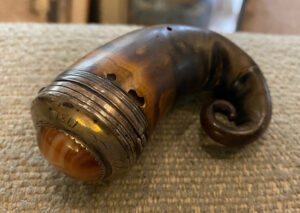 KM sent me a pretty little Scottish snuff mull, engraved Sheffield Silver Mounts, 1817. Large at over three inches, they sat on a table or sideboard to serve “all” who wanted snuff. That’s another story…why anyone wanted to make themselves sneeze. Particularly notable today when we consider sneezing NOT a good thing.
KM sent me a pretty little Scottish snuff mull, engraved Sheffield Silver Mounts, 1817. Large at over three inches, they sat on a table or sideboard to serve “all” who wanted snuff. That’s another story…why anyone wanted to make themselves sneeze. Particularly notable today when we consider sneezing NOT a good thing.
The inscribed date of 1817 on the MULL intrigued me. What went on in the time the giftor received this snuff mull? We cannot take the object OUT of its era, so I researched 1817 in Scotland.
In 1817 Scotland
Typhus raged in Edinburg and Glasgow, a mini pandemic. William Ritchie founded the famous newspaper, The Scotsman. In case you needed whisky to go with your evening read, two distilleries, Bladmoch and Teaninick, opened on the same day in 1817. The first steam locomotive ran on rails in the mountainous area of Scotland. The poet Robert Burn’s body was “moved” after many years dead (D. 1796), to Dumfries. In other literary news, Walter Scott’s Rob Roy got published.
Now we deal with Britain….
We know Scotland checkered past with English rule. When someone handed over KM’s mull, with love, in 1817, George III (1738-1820) sat on the throne. The world knew him as a tormented monarch with many credits to his long reign. He defeated France in the Seven Years War, establishing Great Britain as the dominant Power in the Americas and India. But then, we fought back in the American War of Independence. SO not so favorable for George in America….that tormented George too. Read on for more tormenting…
George achieved other glories to think about – he defeated Napoleon at Waterloo in 1815, two years before the inscription on KM’s mull. To his great credit George III, in 1807, banned all transatlantic slave trade coming into Britain.
George Lived an Interesting Life
Historians call him a stalwart husband with a happy marriage. Opposed to other kings, we find no records of his mistresses. Is that the sign of a healthy marriage? WAIT! No, I see a sign of a VERY successful marriage. With his wife Princess Charlotte, he sired 15 children, and oversaw their education. Sight unseen he married his princess, and they lived happily until his mental illness showed itself.
Today we diagnose mental illness with a chemical reason. Indeed in 2005 when scientists examined pieces of George’s hair, they found his blood contained high levels of arsenic. Was it through chemicals in the make-up? The medicines? Or poison?
In any event in 1817 some powerful Scottish legal minds didn’t mess too much with England, and ruled Scotland themselves. One, Lord Advocate Lord Meadowbank, Alexander Macanochie (1777-1861) educated at the high school in Edinburg, and later at the University of Edinburg, where I did graduate work. He hated those seditious weavers of Glasgow. Yet he himself remained subjected to the strange and wonderful “Scot’s Law,” a curious blend of common and civil law that STILL holds in place in Scotland, one of the three legal systems of the UK. A patron of the arts, he frequented the Edinburgh Smasher’s Club, a drawing (and drinking) Club.
James Wedderburn, who died at thirty-nine years old (1782-1822), served as Solicitor General when KM’s Mull was gifted. Interestingly his daughter Jemima, a fabulous artist, illustrated many books in the style of Audubon. His many sons became successful, AND a gifted artists daughter who, in the tradition of her time, signed with her husband’s name, and who outlived her brothers in the history of Scottish artists.
What’s such a Scottish Snuff Mull worth?
From the early 19th century with such history around it? There are collectors of course and they will pay $300 for a plain piece, and if it comes with a jewel on the top, or a nice Scottish agate, they will pay $600. I know, dear reader, you might think, why is Elizabeth Stewart so interested in this? I have a piece of my own history in Scotland….after all, I am a Stewart.